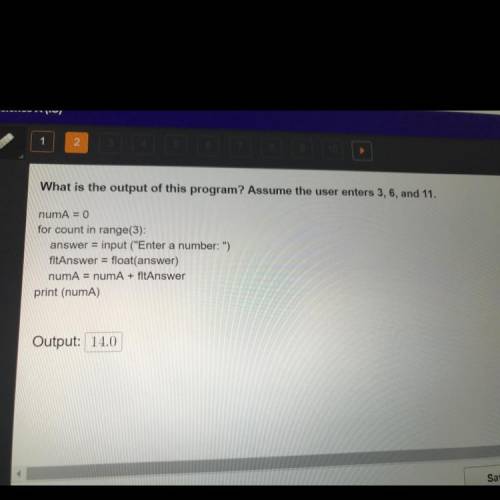TIMED PLS HELP
What is the output of this program? Assume the user enters 3, 6, and 11.
numA...

Computers and Technology, 04.01.2021 18:30 michaelgold1
TIMED PLS HELP
What is the output of this program? Assume the user enters 3, 6, and 11.
numA = 0
for count in range(3):
answer = input ("Enter a number: ")
fitAnswer = float(answer)
numA = numA + fitAnswer
print (numA)
Output:


Answers: 2
Another question on Computers and Technology

Computers and Technology, 22.06.2019 19:20
Write a program that prompts the user to input a string. the program then uses the function substr to remove all the vowels from the string. for example, if str = "there", then after removing all the vowels, str = "thr". after removing all the vowels, output the string. your program must contain a function to remove all the vowels and a function to determine whether a character is a vowel.
Answers: 2

Computers and Technology, 23.06.2019 14:00
Technician a says that with self-adjusting clutch systems, the release bearing constantly rotates. technician b says that the ball bearing portion of the release bearing should be lubricated with high-temperature grease during routine maintenance. which technician is correct?
Answers: 2

Computers and Technology, 24.06.2019 14:40
Create a function (prob3_6) that will do the following: input a positive scalar integer x. if x is odd, multiply it by 3 and add 1. if the given x is even, divide it by 2. repeat this rule on the new value until you get 1, if ever. your program will output how many operations it had to perform to get to 1 and the largest number along the way. for example, start with the number 3: because 3 is odd, we multiply by 3 and add 1 giving us 10. 10 is even so we divide it by 2, giving us 5. 5 is odd so we multiply by 3 and add one, giving us 16. we divide 16 (even) by two giving 8. we divide 8 (even) by two giving 4. we divide 4 (even) by two giving 2. we divide 2 (even) by 2 to give us 1. once we have one, we stop. this example took seven operations to get to one. the largest number we had along the way was 16. every value of n that anyone has ever checked eventually leads to 1, but it is an open mathematical problem (known as the collatz conjectureopens in new tab) whether every value of n eventually leads to 1. your program should include a while loop and an if-statement.
Answers: 3

Computers and Technology, 25.06.2019 12:50
Which of the following activities is an example od gathering data by observation
Answers: 3
You know the right answer?
Questions

History, 21.06.2019 20:30


Social Studies, 21.06.2019 20:30




World Languages, 21.06.2019 20:30

Mathematics, 21.06.2019 20:30

English, 21.06.2019 20:30



Mathematics, 21.06.2019 20:30



English, 21.06.2019 20:30

Chemistry, 21.06.2019 20:30







